PYMNTS Intelligence: How CUs Are Implementing Contactless Payments and Mobile Wallets

The financial services industry has changed radically over the last 10 years as financial institutions (FIs) of all types have had to expand their product offerings to meet consumers’ ever more technologically advanced expectations. The move to mobile wallets and contactless payments is one of the newest examples, having received a major boost under the pandemic’s influence.
Digital transformation has forever changed the face of business, and while some FIs have swiftly pivoted to adopt new technologies, credit unions (CUs) have often had difficulty in keeping up with these developments. Credit union members’ needs and preferences are changing along with everyone else’s, however, and that means CUs must develop solutions to fulfill these needs in both the short and the long term. This month, PYMNTS Intelligence examines how mobile wallets and other touchless payments are evolving in the CU space.
How CU Members Are Using Mobile and Other Touchless Payments
The pandemic accelerated consumers’ demand for contactless payment methods that could offer greater safety and convenience as in-person operations rapidly shifted to digital. According to research from PSCU, consumers are increasingly opting for mobile wallets, digital payments and contactless cards, as well as other tap-and-go payment products. The share of respondents who reported using mobile wallets increased by half within a two-year period, growing from 14% in 2019 to 21% in 2021. Thirty percent were leveraging mobile wallets multiple times per month, and 40% said they were “likely” or “extremely likely” to utilize mobile wallets at some point over the coming six months. Respondents said they used mobile wallets primarily because they were convenient, easy to use and fast, and their most common reason for not using them was unfamiliarity with the technology or how to use it.

Contactless card usage has also grown by leaps and bounds in recent years, with respondents increasing their use of the cards 124% since 2019, a shift from just 25% to 56%. Nearly 90% of respondents with contactless cards reported using them a few times per year at least, up from a pre-pandemic 65%, and CU members with contactless cards were using them at big-box retailers and grocery stores at rates of 45% and 55%, respectively. Although 59% of consumers still preferred to use EMV chip cards at in-store point of sale (POS) devices, nearly one-third — 29% — were choosing to pay with tap-and-go contactless cards.
PYMNTS’ research from February 2022 shows that CU members’ interest in contactless payment features is reaching a point at which many would switch to rival FIs if their CUs did not offer them.
How CUs Are Keeping up With Members’ Touchless Preferences
Over the last few years, many CUs have focused on bringing innovative products to their members to compete with big banks that also have bigger innovation budgets. While many of these efforts have been successful, recent data shows that CUs may be faltering somewhat in this regard. Although 64% of American CUs invested in mobile wallet technologies and platforms in 2021, this actually represented a decline from 2020, when 86% made these investments. On the other hand, the number of CUs investing in peer-to-peer (P2P) payments has almost doubled, rising to 50% in 2021 from 27% in 2020.
CUs that consider themselves “early launchers” — organizations that are ahead of the curve regarding innovation — are more likely to innovate features such as mobile banking capabilities, mobile wallets, personal loans, data analytics, buy now, pay later (BNPL) options and tools to help members plan their finances and budgets. These innovations, which might once have been seen as nice-to-haves by members, are becoming prerequisites. PYMNTS’ February study showed that more than one-third of CU members would switch to competitor FIs if their CUs did not offer digital wallets, P2P payments, mobile check deposits and cardless cash withdrawals.
The group of “early launcher” CUs has risen steadily over the past four years to 19% in 2021, compared to 12% in 2020, 8% in 2019 and 4% in 2018, illustrating CUs’ growing comprehension of the importance of innovation. Member preferences are still in flux, however, and most CUs’ infrastructure has not kept pace. Technology silos persist across channels, creating inefficiencies and disrupted experiences that contribute to member dissatisfaction. As members’ expectations grow, these legacy processes will become increasingly untenable.
Mobile wallets and other contactless features are now must-haves for CU members, and the most responsive CUs are developing these offerings. As digital banking continues to evolve, innovating these offerings promises to help CUs punch above their weight in attracting and retaining business.